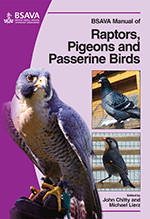
Full text loading...

Many predisposing factors to upper and lower respiratory diseases in falcons are management-related. The ideal environment should be well ventilated and free from dust and toxins, while proper nutrition is necessary for a healthy immune system. This chapter discusses clinical signs and differential diagnosis; upper respiratory tract; lower respiratory tract; and treatment.
Raptors: respiratory problems, Page 1 of 1
< Previous page | Next page > /docserver/preview/fulltext/10.22233/9781910443101/9781910443101.20-1.gif

Full text loading...















